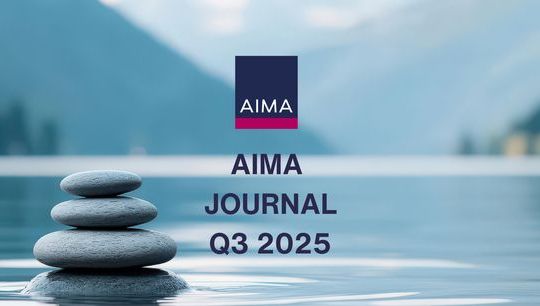Ep. 42 The Long-Short | 2022: The year of the CTA strategy
Published: 19 October 2022
The Long-Short is a podcast by the Alternative Investment Management Association, focusing on the very latest insights on the alternative investment industry.
Each episode will examine topical areas of interest from across the alternative investment universe with news, views and analysis delivered by AIMA’s global team, as well as a host of industry experts.
Amid continued instability being experienced in global financial markets, managed futures are once again demonstrating their worth to certain investor portfolios, with the average performance from a managed futures fund returning more than 10% net of fees for investors this year.
In the latest episode to drop Kevin Donohoe, Head of Research at Abbey Capital, speaks to The Long-Short about these alternative strategies.
Listen to this episode and subscribe on Spotify
Listen to this episode and subscribe on Apple Podcasts
Listen to this episode and subscribe on Google Podcasts
Listen to this episode and subscribe on Amazon Music
Read the transcript
Hosts: Tom Kehoe, AIMA; Drew Nicol, AIMA
Guests: Kevin Donohoe Head of Research at Abbey Capital
Interlude: Scarlet Buhagiar, AIMA
Tom Kehoe, AIMA 00:05
Now, it has been well documented about the challenges being currently experienced across financial markets amidst heightened geo-political tensions, inflation levels not seen in nearly fifty years with stock markets plummeting in value through the course of this year. The S&P 500 and the MSCI World being down over 20% year to date, while a typical 60/40 portfolio (a long-cherished investment strategy for pension plans and other conservative institutional investors) is down approximately 16%.
By contrast, hedge funds on average are down approximately 4% year to date with some hedge funds delivering some very strong returns. But that is not all the story, performance dispersion is prominent, with some significant gains being reported for investors, while certain strategies continue to deliver.
Drew Nicol, AIMA 01:43
Among these are managed futures strategies, which are enjoying something of a renaissance with the average CTA returning over 10% net of fees for investors year to date. So, what are these recession busting strategies?
To help us understand more, we are delighted to be joined by Kevin Donohue, head of research at Abbey Capital and alternative investment and fund manager that specialises in managed futures. Kevin has more than a decade of investment experience in investments, and managed futures and is integral to all aspects of Abbey’s investment process and portfolio construction.
Tom Kehoe, AIMA 02:14
Kevin, you're very welcome to The Long-Short.
Kevin Donohoe, Head of Research at Abbey Capital 02:16
Thanks, Tom and Drew. It's great to be join you here today. Thanks very much for the opportunity to come and speak on managed futures.
Tom Kehoe, AIMA 02:23
And let's start then with the term managed futures, that covers a wide range of different strategy types. Could you give a sense to our listeners as to how this industry has evolved over time?
Kevin Donohoe, Head of Research at Abbey Capital 02:34
Yeah, absolutely, at just under US$400 billion in assets under management, the managed futures industry represents a little under 10% of estimated global hedge fund assets. We often hear this space referred to by various names such as managed futures, CTAs, trend following or systematic macro. In reality, many of these different terms are quite interchangeable, and they're essentially describing very similar things. The term commodity trading advisor, CTA, can be traced back to the CFTC Act in 1974, which itself is built on other pieces of legislation from earlier in the 20th century. And these acts are really looking to bring more regulation and coherence to commodities and futures trading that had its origins in the establishment of the Chicago Board of Trade and grain trading of the mid-1800s. So, it helped to define the role of CTAs and CPOs (commodity pool operators), who were active professional managers who were working more routinely with derivative markets than traditional stock market fund managers.
Today, many of those terms I referenced earlier are synonymous with the managed futures industry. Or they describe specific styles of trading within it, such as trend following for example, it's an industry that's really seen continuous evolution over time, as markets and systems and trading techniques have changed. CTAs have also evolved greatly in response to that. So, the industry has become far more institutionalised and professional, with increasingly high focus on risk management techniques, I would say. And we've also seen the breadth of markets traded by these managers expand a lot in recent years, which has resulted in exposure to a very wide range of potentially diversifying asset classes.
Drew Nicol, AIMA 04:26
How does Abbey define or characterise the various styles within the managed futures universe?
Kevin Donohoe, Head of Research at Abbey Capital 04:32
At the simplest level, we typically break the universe of managers down by defining them first as either trend following or non-trend following. We refer to this internally as a core satellite approach. It helps us to define the approaches of individual managers in the industry, but it also extends to how we consider the allocation of risk within the funds we managed, so, it’s an important concept for us. In our view, the overall categorisation includes a few distinct trading styles. When we think of a core trading style, we think specifically of trend following. Many of your listeners will know this is a systematic style of trading that enables managers to potentially take advantage of trends in markets with positions typically taken over multiple weeks and even at times multi-month horizons. The inputs of these traders will often primarily focus on price data in markets.
In terms of the satellite classifications, this would be made up of predominantly non-trend strategies. These can be strategies that may be complementary to trend following over the long-term, by having a consistently or structurally low correlation to trend. They’ll often use different inputs to trend following strategies such as incorporating more fundamental or bespoke datasets, for example, in terms of how Abby Capital would define them, they would break down into things like short term systematic traders, so momentum and mean reversion opportunities over a shorter time horizon, global macro managers, both from a discretionary and systematic perspective. And this is where we really see some of the fundamental data set come into play. Value or relative value managers, and then counter trend managers as well. So, the important thing we look for in these types of managers is their diversifying profile compared to trend following and compared to one another, as this is an important consideration for us when we are building portfolios.
Tom Kehoe, AIMA 06:27
Kevin, how would you describe the merits and potential pitfalls of managed futures investing? What do you see as the key characteristics?
Kevin Donohoe, Head of Research at Abbey Capital 06:39
Yeah, in terms of merit, Abbey's approach to the industry begins with a very strong conviction that we have in in the potential benefits of managed futures in a broader portfolio setting. We believe that markets exhibit trends and repeating price patterns, and that this is due to economic and behavioral factors. So, we think that systematic and discretionary traders can potentially capitalise on these repeating patterns over time. Over the long-term, we've observed managed futures offering a significant diversification benefit to traditional asset classes, such as equities, and bond portfolios, and there are various reasons why it's tended to have this low correlation to traditional assets. It's bidirectional in nature, so it often takes long or short positions in markets as trends evolve. It trades in multiple asset classes, and it tends to perform best when there are strong trends in markets and can potentially offer diversification, particularly during market stress events, and certainly this has been a feature of it historically.
Key characteristics of the space are also related to liquidity trading, mostly in exchange listed futures contracts. CTAs typically delivered their strategies in a very liquid way, with real daily liquidity offered to their clients. And this is an important consideration for investors, and something we often feel is underpriced in markets. CTAs have, in the past, been a very important provider of liquidity to their clients during stress events in markets. In terms of the pitfalls of strategies like this, we can see periods of sustained low volatility in markets which can be challenging for managed futures managers. Periods of directionless sideways markets are choppy trends can also be periods where they'll tend to underperform, relatively speaking.
Overall, it's very difficult to time markets, to time when and where trending opportunities might present themselves. From our perspective, it's important to consider time in the market as opposed to specifically attempting to time it.
Drew Nicol, AIMA 08:43
You touched on it a little bit there. But if I could just ask you, what is Abbey Capital’s particular investment philosophy and approach when allocating to managed futures?
Kevin Donohoe, Head of Research at Abbey Capital 08:54
Yeah, Abbey Capital's investment philosophy has always been equities for the long-term with managed futures as an effective diversifying strategy alongside this as a compliment. From a managed futures perspective, the multi-manager approach is really central to what we do here at Abbey.
One of our key investment objectives I would say is that we want to build robust rather than optimised portfolios. So, individual managers within a portfolio might have a more optimised approach to markets themselves. But we look to blend differentiated trading styles with the aim of delivering a more robust portfolio level offering. We don't want to create portfolios that are tuned to a transient or a short-term effect in markets. We want our portfolios to complement traditional asset classes over the long-term. The CTA industry has a couple of key characteristics, I would say, that are important in why we have such a high conviction in this blended multi-manager approach. CTAs have historically exhibited very high dispersion of returns and low persistence of return. So, return dispersion isn't unique to CTAs. But it is quite pronounced in this industry. Very similar managers can have very different return outcomes within the same period.
Historically, we've also seen that it's highly unlikely that the same managers will outperform year on year as the market environment changes. So, we can tend to see a mean reverting effect in manager performance. There's a number of reasons why similar managers can differ so much that they might adopt different trading styles, so trend versus non trend, or even different methods of trend following itself, they might have different risk allocation methodologies, so potentially favoring certain asset classes over others, like a greater allocation to financials versus commodities, for example. Hold periods and risk management techniques are also quite important differentiators. As a result of this, we would feel that managers should be assessed on a broad range of factors rather than recent performance alone. So, our investment process for selecting CTAs, and the proprietary tools and systems that we've developed over the years here, are geared towards helping us understand the drivers of this manager dispersion, what makes managers differ from one another? And how can we utilise this information in constructing a diversified managed futures portfolio? We do this by effectively building a qualitative expectation of an individual strategy over time, and then quantitatively assessing whether we see that expectation evidenced in the data that we analyse.
Tom Kehoe, AIMA 11:40
Kevin, how does Abbey Capital’s approach differ from other participants in the industry?
Kevin Donohoe, Head of Research at Abbey Capital 11:45
Yeah, Tom, we we've always placed a very strong emphasis on the importance of building and sustaining relationships with our managers. These are long-term partnerships. And so we take a long-term view when it comes to the process of due diligence with an individual manager. As I mentioned before, we focus very strongly on the quantitative and qualitative understanding we have of managers and their strategies. Understanding them in this way can allow us to sit with them through inevitable drawdowns as long as the performance and profile we're seeing matches our understanding. So, this is a key benefit of the multi-manager approach in our view. Importantly, the funds we manage only allocate to managers through separately managed accounts. It gives us a lot of transparency into the positions and P&L of the strategies that we allocate to and also provides us with daily liquidity on these strategies, which we can subsequently pass to our investors.
[Interlude] Scarlet Buhagiar, AIMA 12:43
Drew Nicol, AIMA 13:30
We’ve seen a diverse range of themes driving elevated macro and geopolitical volatility in the past 18 months. This has often translated into increased market volatility. How have these themes impacted the way you think about the process of portfolio and risk management?
Kevin Donohoe, Head of Research at Abbey Capital 13:50
Yeah, for us, the challenge of portfolio and risk management remains very consistent through, and process driven even through market environments, like we've seen recently. Our thinking isn't impacted by transient or evolving market conditions, and this comes back to the belief we have that you cannot time when or where trend following opportunities might present themselves. In our approach, it's important that we retain consistent allocations of risk over the long-term to the various differentiated trading styles that we identify as well as the various market sectors that our managers trade. In 2022, for example, we've seen a substantial rotation of trending opportunities through different manager styles at different times, and also, through a number of different market sectors. The opportunity set has evolved dramatically, actually, as the year has progressed.
Tom Kehoe, AIMA 14:43
Kevin, we touched on it in the introduction, the performance from managed futures strategies have improved recently, not only compared to traditional asset classes but also relative to other hedge fund strategies. What do you believe have been the key macroeconomic drivers of that performance?
Kevin Donohoe, Head of Research at Abbey Capital 15:05
Yeah, Tom, you know, markets are facing uncertainty in real time. As we move from a long period of very low volatility and abundant liquidity to a new environment, which is increasingly focused, it seems, on market fundamentals. The move away from QE and suppressed market volatility has been extremely interesting. And this transition has been an important influence on the performance of the managed futures industry. Interest in CTA strategies as an alternative investment is higher now because of the challenging environment for traditional asset classes as you pointed out earlier on. But in reality, the conditions for CTA strategies have experienced improvement further back than just this year. And a major driver of this, I would say has been the return of macro volatility and uncertainty to markets. This has had an impact on market volatily, which as it has increased has helped to create an improved opportunity set for managed futures strategies.
In 2019, for example, we saw sharp moves in fixed income markets as rates moved lower that created trending opportunities for many CTAs. In 2020, COVID-19 introduced a huge risk event to markets, and that elevated volatility brought opportunities in things like equities and commodities as the year progressed. And in 2021, then was a period of global economic reopening, as we know, that created a deflationary environment, and trends across commodity markets, especially seen in energies, base metals, and agricultural contracts. This year has seen that environment really developed further, the inflation pressures that build through 2021 were partly driven by those higher commodity prices, that was essentially an input to that higher inflation that we were seeing through Q3 and Q4. Inflation is effectively an accelerated price trend. And this has historically been associated with periods of positive performance for CTAs. In 2022, we've seen those second order impact of inflation really start to dominate in terms of the response of market participants to the inflation.
The start of the year saw commodities continue to contribute positively for most managers, or a lot of managers. But higher rate expectations also lead to very strong trending opportunities on the short side of fixed income markets. And then more recently, as central banks have juggled the need for tighter monetary policy to battle inflation, against the backdrop of growing fears of slowdown and recession, this has helped to give rise to policy divergence as we know, and what we’ve seen there is strong trends developing things like currency markets as well. So that’s been a key feature of that performance.
Drew Nicol, AIMA 17:48
And something we’re always keen to stress here is that, although those headline figures around hedge fund index performance are useful, you often need to be more granular to get a greater idea of the dispersion within the strategies. And likewise, you mentioned managed futures themselves, you can dig even deeper and get quite a lot of dispersion between the various strategies that you outlined earlier. Could you just give us an idea of how performance has varied across the managed features space this year?
Kevin Donohoe, Head of Research at Abbey Capital 18:20
Yes, as we typically expect, we've seen dispersion of returns across managers in the industry. Generally speaking, each of the trading styles we spoke about earlier, have experienced broadly positive performance, although the timing has often been different. And I think that's been important to note, trend following managers did particularly well in the moves seen in Q1 and again during Q3. So, those long commodity, short fixed income, and more recently, short fixed income and long dollar positions within currencies. Non-trend managers like short-term, and macro, saw they're stronger periods of performance coming more in the second quarter. As market volatility and the influence of fundamental factors can evolve, we'll often see these various trading styles experience differentiated performance compared to one another and the timing of that can be different.
Tom Kehoe, AIMA 19:13
Kevin, have there been any surprises, positive or negative, in your observations around performance?
Kevin Donohoe, Head of Research at Abbey Capital 19:20
Yes, volatility in markets has been higher, and the opportunity set has been quite varied across different market sectors and timeframes. An internal metric that Abbey uses is to track the percentage of futures markets that are defined to be in a trending state at any one time. This measure is showing that the percentage of markets trending during 2022 is at levels that we haven't seen since 2009. So, it's illustrative of the favourable environment I would say that many CTAs have been experiencing.
It hasn't been a positive environment for all managers. So, the higher volatility and increased macro uncertainty has resulted in quite a large degree of performance dispersion in the space. Beyond the longer term averages, we would tend to see actually, in our view, this type of environment can illustrate the potential benefit of considering a multi-manager approach within managed futures. An interesting note, to mention as well as the tailwind to performance that the industry, the wider industry, is experiencing due to higher interest rates. Given that much of the trading is implemented through exchange traded futures, the positions are funded on margin. This can mean that at any one time, approximately 70% or so of the cash invested in a fund is not being used to fund margin and can be used to earn a yield. The higher rates this year are providing an increasingly strong return on this free cash.
Drew Nicol, AIMA 20:53
That's interesting, I didn't think about that initially. We obviously have to ask about the potential challenges as well. You've mentioned timing there, and obviously, volatility coming from a wide number of macro trends this year. But just more broadly, what are the potential challenges that this type of environment does bring to these strategies and the wider business?
Kevin Donohoe, Head of Research at Abbey Capital 21:18
I would say that the ongoing education process with clients and prospects is really important at a time like this. The strong performance itself can become a real focus for people. But in our discussions, we try to focus less on the specifics of the performance, and more on the longer-term profile of managed futures and the multi-manager concept. You know, we feel this is really important to help investors understand the strategy more and its expected return profile. There will inevitably be drawdowns as market conditions evolve. So, we take a longer-term focus on the diversification and correlation profile of these strategies and try to contextualise the current performance within that longer-term understanding.
Tom Kehoe, AIMA 22:03
Now switching gears a little. The pandemic accelerated work from home and a rethink of the operational infrastructure of many investment managers. Here on The Long-Short, we have documented a lot about working remotely and how businesses have become more cloud-based – how has that affected how you conduct operational due diligence?
Kevin Donohoe, Head of Research at Abbey Capital 22:27
Yeah, I mean, whether we think about investment or operational due diligence, for us, the building and sustaining of strong relationships with our managers has been hugely important over this time, as you can imagine. As the pandemic hit, the ability to adapt to a remote first environment was key for this industry as it was for many others. Ensuring a robust, secure technology infrastructure was hugely important to that switch over. The pandemic brought about an increased focus on how systems are accessed by staff, for example. This was already a key part of what we would have focused on. But more so now as the number of locations changed from a few offices to every staff member, home effectively becoming an office. So, it's been important to understand how the control environment has evolved within managers, how our devices locked down, for example, staff could be using the same device, as their children are using for school or leisure. So, if a firm is allowing this, how are they controlling for it?
Another area is to understand what cyber controls firms have put in place to watch for attempted data breaches. Data loss prevention becomes very important at a time like this, so how staff are trained, and the need for firms to reinforce good practices on a continuous basis has been very important. In reality, and in the view of our own ODD (operational due diligence) team, the use of well-constructed cloud-based systems, there's no more risk than in House hosted systems. In most cases, cloud-based providers are going to do a better job at securing their environments than we can as managers. But we have a responsibility to ensure that diligence is conducted on all our cloud providers just as we do for our brokers and other counterparties. We can't abdicate that responsibility because it's in the cloud as it were. So, vendor management is just as important and must cover all our providers.
As you can imagine, we moved to a virtual operational due diligence when the pandemic hit, I would say there were a number of benefits to this approach we had reduced spend on travel, both in terms of the cost of the travel itself, but also the cost of people's time. Video conferencing allowed us to include more subject matter experts on our own side, and also to get access to more of the key people in the managers business irrespective of where they were located. We did also see some negatives. You know, some allocators were hesitant to make material and decisions without the ability to make the physical visit. And as travel has reopened, we've favored a return to the on-site visit. It allows for physical verification of documentation and key processes on the on the trading floor, for example. But there have been benefits from the past few years that continue to have a positive influence on the ODD process overall, I would say.
Drew Nicol, AIMA 25:24
You mentioned investors there, and we should spend a little time on those, because we talked about managers a fair amount here. What has been the response of investors to the recent macroeconomic and performance environment? What has been your experience of the landscape from a business development perspective?
Kevin Donohoe, Head of Research at Abbey Capital 25:44
Investors have faced renewed uncertainty in markets in the past year, and really from the pandemic period, obviously, the macro environment is changing. We're in a live regime shift and this can potentially make investors nervous. Economies are showing signs of slowing, we have higher interest rates, and we've seen persistent inflation. Buying on the dip in equities as a strategy has worked well for a long time. But that's now being called into real question. The focus will increasingly be on preserving wealth. So, liquidity becomes important. We see this from our clients, but often people are slow to move when environments shift like this.
In terms of our own recent observations, the US market is certainly moving more now. We've seen major flows into mutual funds that cover CTA funds as well as multi-asset and return stacking solutions that the wire houses and broker dealers. Model money within these has been on the move away from fixed income into alternatives, and managed futures has benefitted here. On the use of CTA front, that market is holding, but is still below historic asset highs that we would have seen back in 2017.
Institutional flows then in Europe, the Middle East, and Asia are slower. Typically, the institutional channels are advised by global and regional investment consultants. It's fair to say that consultants are increasing their interest in the space, in the managed futures space, particularly as they and their clients increasingly look for diversification and liquidity over the coming periods. We've seen European pensions and multifamily offices investing in our private placement solutions this year, but it's not a deluge at this point. It's a continuation of relationships established over a decade, and where we've spent time constantly educating on the potential merits of the CTA offering, there can often be a lag between performance and institutional allocation. And so that's really what we expect to see in the institutional space, I would say.
Tom Kehoe, AIMA 28:00
Kevin, this has been a fascinating conversation, it's interesting to hear from you that it's not just institutional investors that are taking notice of the quality of managed futures, particularly in this climate. Where might our listeners get to read more, I guess, about CTAs and managed futures? Is that something that you make available on your website?
Kevin Donohoe, Head of Research at Abbey Capital 28:24
Yeah, we do. We have various links and stories on our website (abbeycapital.com), where hopefully, we are able to continue that education process that I spoke about earlier on. So that's certainly a starting point for some in terms of their journey and understanding the potential merits of managed futures investing.
Tom Kehoe, AIMA 28:46
And again, for those listeners who are familiar with our own work on aima.org, we did a paper back in 2017, ‘Riding the Wave’, which is a primer on the managed futures strategy and indeed, our friends at Abbey Capital helped contribute to that piece. So, thank you again for that. And thank you, Kevin, for joining us today.
Kevin Donohoe, Head of Research at Abbey Capital 29:09
Thank you, Tom. Thank you, Drew. It’s been a pleasure to speak to you both today.
Disclaimer
This podcast is the sole property of the Alternative Investment Management Association (AIMA). This audio production and content are intended as indicative guidance only and are not to be taken or treated as a substitute for specific advice, whether legal advice or otherwise. AIMA permits use or sharing of the content in media or as an educational resource, provided always that proper attribution is made. The rights in the content and production, including copyright and database rights, belong to AIMA.







